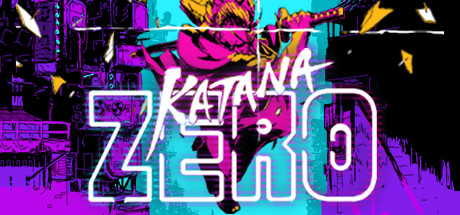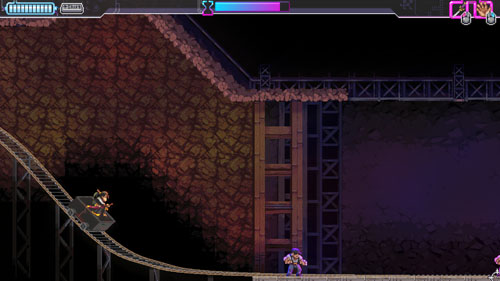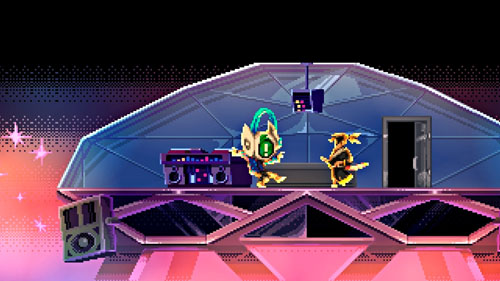A game by Askiisoft for PC, Mac, PS4, and Switch, originally released in 2019.
Katana ZERO is a melee-based actioner with a unique twist in terms of its presentation. The main character is a katana-wielding martial artist who is referred to only as The Dragon, and he receives contracts to infiltrate various facilities, wiping out the opposition – or occasionally avoiding them – while taking out many key figures in a grand conspiracy, the details of which are purposely kept from him. As The Dragon works through his list of kills, he slowly begins to unravel this mystery, much to the chagrin of his employer.While this sounds like a fairly standard setup for an action game, what sets it apart from other genre entries is the anti-hero’s ability to perceive time differently than most people, as evidenced by the fact that missions are referred to as planning sessions. From the player’s standpoint, these missions play out as typical action sequences, but getting killed returns the player to the beginning of the level with the protagonist stating “No… That won’t work”, indicating that he has looked into the future to see how his possible strategy (the player’s actions) may succeed or fail.
This precognition comes by way of a drug that is administered to the protagonist by his psychiatrist during between-mission debriefings, where the psychiatrist pries into his memories and berates him for acting against any of his instructions, such as letting a target speak instead of killing him right away. The drug in question is called Chronos, and it is at the heart of the conspiracy that the protagonist slowly uncovers. This drug also gives the developers license to occasionally screw with the player’s perception of events, with several sequences that include time jumps or time loops to suggest that the protagonist is experiencing time differently.
The player character is able to perform a 1.5x variable jump and can slash in eight directions. Attacking jumping allows him to hang in the air for a moment, and attacking upward or at an upward angle gives him additional height on his jump, allowing him to reach higher platforms. He is also able to duck and perform a dodge roll. Dodge rolls are often used to get in behind enemies or to avoid enemy fire, but the game's action is quite fast, so it’s possible to be killed quickly by mistiming this maneuver. For instance, if an enemy has a machine gun, the player may dodge through the first bullet only to get hit by the second, or the sound of gunfire may alert another enemy to his presence.
This is balanced by a limited slow motion effect that allows the player to slow time to a crawl, which drains a battery gauge at the top of the screen, and this gauge recharges slowly over time. By engaging slow motion, players may more quickly close ground on enemies before they react, and they can more easily determine the proper timing for performing attacks and dodge rolls. More importantly, moving in slow motion makes it easier for the player to slash incoming bullets with his katana, reflecting them back to the enemy who fired them, which is one of the few ways that the player can deal with distant enemies.
Combat is kept fast by the fact that most enemies are killed with a single swing of the sword, although some can parry with swords of their own, requiring the player to follow up with a secondary strike. Players can occasionally pick up throwable objects, such as beer bottles, potted plants, or hatchets, which can be tossed at an enemy for an instant kill (provided the enemy doesn’t shoot it out of the air or slash it down). Other throwable objects include fire extinguishers and Molotov cocktails. Fire extinguishers obscure enemy vision, allowing you to take down multiple gun-wielding baddies without them being able to retaliate, and this can occasionally be used to bypass security cameras. Molotov cocktails explode on contact and can also be used to ignite explosive barrels for huge chain reactions that take down multiple foes… and you, if you’re standing too close.
Each failure results in death and a return to the start of the level, but levels are short, and repeated play helps the player to develop better strategies on the next attempt. Furthermore, most missions are captured on security footage, which plays back in grainy black and white at the end of each mission. This playback – which may be paused, rewound, or fast forwarded – allows the player to see his actions in real time, playing back any slow motion movements at full speed.
The result is a playback that makes you appear to be a complete badass, reacting to enemy attacks with swift and fatal responses as you scurry though the level unharmed. That said, skilled players my find strategies that require very little use of slow motion effects, and so playbacks will show actual player actions through the level. The level select screen also leans into this retro aesthetic, with level names appearing as labels on VHS tapes.
The player can use the environment to his advantage in a number of ways, as the player is able to break through certain floors and ceilings to take enemies by surprise. Additionally, the player character is very agile and is able to walk across wires or perform triangle jumps between walls to quickly ascend. Kicking open doors also offers some strategy, as the player can use this technique to kill guards standing on the far side. However, the player must be mindful of enemy behaviors, as gunfire will attract nearby enemies… but this can also be used to the player’s advantage to draw entrenched foes into a more favorable kill zone. Levels are designed so that there are multiple possible solutions, allowing players to take advantage of strategies that fit their playstyles.
The game occasionally shifts away from straightforward melee combat, offering some variety between missions. On one mission, the player is asked to make it through a large area without killing any of the patrolling police officers. The player is able to move behind objects and avoid light sources so that enemies walk right past without being able to see him, so success is a matter of moving at the right time, taking advantage of the environment, and avoiding flashlight beams. Or, the player can just go nuts and kill everyone, which will anger the protagonist's employer.
One area is comprised of an extended mine cart sequence where you must hit switches to open doors and occasionally jump off to deal with baddies. The mine cart keeps moving regardless of your actions, so you have to time your movements properly in order to get back on before it gets away from you, and you need to protect it from being destroyed by closed doorways. One challenge has you walking beneath the mine cart as it rolls along above you, interrupting laser beams that would otherwise kill you.
There’s also a motorcycle chase sequence on a highway, but this is actually easier than most standard levels since you don’t need to worry about enemy lines of sight or moving silently. This is a straightforward action sequence where you get up alongside enemies to slash them with your sword. Enemies have a long pause between attacks, and even the guys with guns take a long time to fire, so you’re free to move around and deal with foes while occasionally dodging incoming fire. There are also multiple checkpoints here so failing doesn’t require much repeated play.
The motorcycle sequence gets a bit more challenging when indestructible vehicles are introduced, but there’s an icon to tell the player when these are about to appear. This lets the player dodge them and prioritize his attacks since some enemies will be destroyed by crashing into these vehicles. At the end of this level is a boss fight against a helicopter that has a sniper hanging off the side. This boss alternates between bomb drops and sniper shots, but the helicopter flies too high for you to reach with your attacks. Instead, you must deflect sniper bullets back at the helicopter to knock it out of the sky.
The story slowly unfolds as you engage with various enemy characters and your psychiatrist, but there are also several sequences that take place at your apartment, and these often center around your interactions with the little girl who lives next door. Inside your apartment, you can watch TV, which usually reports on your deadly activities from the night before, interspersed with a few darkly humorous dystopian stories. Falling asleep on the couch often results in nightmares that unfold in unexpected and occasionally horrific ways, and some of your work activities spill over into your home life.
An interesting part of the narrative is the fact that you are free to interrupt almost any conversation by shouting or cursing at the person before they finish speaking, which leads to characters becoming angry with you. That said, waiting for the character to finish speaking generally results in a selection of more thoughtful responses that are more likely to get you the information you need. Dialogue can even help you with your missions, such as one sequence where you speak to a hotel receptionist who seems to ask endless mundane questions… but if you’re nice to her and respond to her questions, she’ll back up your story when you come back downstairs from murdering everyone, allowing you to leave the building unchallenged.
The narrative is often relayed in a purposely haphazard manner as the player engages with other characters only to have things go all glitchy, followed by the player character being in another area entirely, confused about what has transpired in the meantime. The player occasionally engages enemies who have their own Chronos-enabled powers, and he manages to survive an interrogation sequence by learning information through precognition. The humor is generally dark – and often quite violent – and there are some occasional humorous nods to the player, such as a couple of references to Silent Hill. While the overall tone of the game is dark, the visuals are interspersed with occasional bits of vivid color to liven things up, and characters are given a great deal of personality through their detailed animations. The game is accompanied by an energetic 80’s-style synth soundtrack.
2D CRED
Katana ZERO was developed over the course of five years by Askiisoft, founded by Justin Stander in 2008 and based in Delmar, New York. This was the studio’s first commercial release, following the release of OverPowered, Pause Ahead, and Tower of Heaven.
The game was published by Devolver Digital, which has published a number of 2D indie games including Serious Sam: Double D XXL, Luftrausers, Broforce, Foul Play, Fork Parker's Holiday Profit Hike, Hotline Miami, Hotline Miami 2, Titan Souls, Not a Hero, Ronin, Downwell, Enter the Gungeon, Mother Russia Bleeds, Serious Sam’s Bogus Detour, Minit, The Swords of Ditto, The Messenger, Crossing Souls, Gato Roboto, Carrion, GRIS, and Witcheye.





























0 comments:
Post a Comment